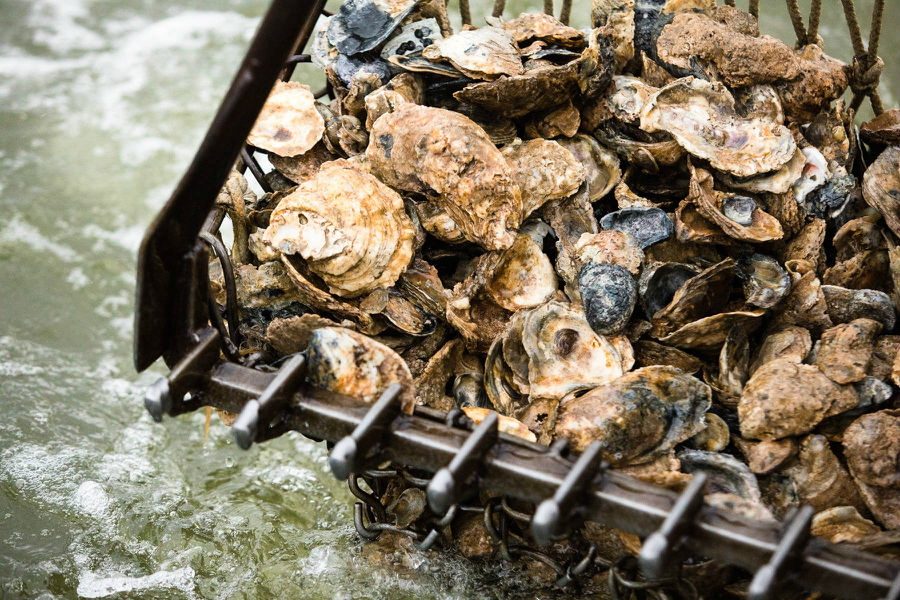Marine bivalves like oysters combine the calcium ions and the carbonate ions into solid crystals of calcium carbonate that they use to form their shells,
像牡蛎这样的海洋双壳类动物把钙离子和碳酸根离子结合成固体碳酸钙结晶,用来形成贝壳,
but hydrogen ions from the dissolved CO2 in the ocean have a tendency to bond with the carbonate ions, leaving fewer available for the newly spawned oysters.
但海洋中溶解的二氧化碳中的氢离子有与碳酸根离子结合的趋势,使新产卵的牡蛎可利用的氢离子变得较少。
The vulnerable stages of any organism are at the larval stage.
任何生物体的脆弱阶段都是在幼虫期。
And so if you start affecting how hard it is for that organism to live,
所以如果你开始影响这种生物体生存的难度,
in this case for an oyster to build a shell, then that's going to lead to problems with it being able to be a viable organism.
具体到这个案例上就是牡蛎要形成壳,这将为它成为一个能存活的生物体带来了问题。
Basically, the more energy the oyster has to waste competing with hydrogen ions for shell material, the less energy it has for growing big and strong.
基本上,牡蛎在与氢离子争夺外壳材料的竞争中浪费的能量越多,它用来长得又大又壮的能量就越少。
It can also result in a weaker shell.
这也会导致外壳变得脆弱。
So that shell now is compromised where it's too thin or breaks easily,
所以现在壳非常薄或者很容易破裂,
then it can no longer seal itself out, seal that that poor water quality out and they will not be viable.
那么它就不能再净水了。
Terry and Dr.Hill are also working together to actually simulate future water conditions in the lab, in order to try to predict what may happen to oysters in the coming decades.
特里和希尔博士还合作在实验室里模拟未来的水环境,以便预测未来几十年牡蛎会发生什么。
We built almost a decade ago, built an experimental setup that kind of operates like a time machine.
我们在差不多10年前建造了一个实验装置,就像一台时间机器。
We can dial in today's carbon dioxide values in a tank.
我们可以在水箱里设置今天的二氧化碳值。
And then in the tank next door we can actually ramp it up and maybe put the carbon dioxide concentrations that you'd see in 100 years.
然后在旁边的水箱里,我们可以把这个数值放大,也许就是100年后你能看到的二氧化碳浓度值。
With acidification levels rising 30% since the Industrial Revolution,
自从工业革命以来,酸化水平上升了30%,
it's critical to be tracking the problem now, and try to work on how to be ready for the future.
现在就要追踪问题,并努力为将来做好准备。

Oftentimes when you hear about ocean acidification, it seems like this sort of distant chemical problem that the ocean is experiencing.
通常情况下,海洋酸化听起来像是海洋正在经历的一种离你很遥远的化学问题。
And if you go to Hog Island Oyster Company and you have, you know you're sitting at a picnic table and you have lunch sitting in front of you,
如果你去了猪岛牡蛎公司,然后在野餐台上吃午餐时,
all the sudden we can talk about ocean acidification in a way that's about a family business, and a coastal economy, and the food on our plates, and a future that we want for our kids.
突然之间,我们在谈论海洋酸化时,可以用我们熟悉的话题来引入,比如家庭企业、沿海经济、我们盘子里的食物和我们希望的孩子的未来。
This data from the lab and the data collected by instruments placed at the farm itself,
实验室的数据和农场里的仪器收集的数据,
all help Terry address acidification by knowing precisely when the pH differences lead to high mortality rates.
所有这些都有助于特里解决酸化问题,准确地知道pH值差异何时会导致高死亡率。
From this, he can figure out which oyster strains are more resilient than others.
从中,他可以找出哪些牡蛎品种比其他品种的适应力更强。
But this won't solve the problem outright.
但这并不能彻底解决问题。
In the end it all comes down to the carbon dioxide that's blasting nonstop into the atmosphere and getting soaked up by the ocean.
最终,这一切都归结为二氧化碳不停地向大气中释放,并被海洋吸收。
I think ocean acidification is a problem that we can confront and change the course of the problem.
我认为海洋酸化是一个我们可以面对并改变进程的问题。
So, just like the other issues that we are dealing with with climate change, the fundamental issue is our carbon dioxide emissions.
所以,就像我们处理气候变化的其他问题一样,根本问题在于我们的二氧化碳排放。
More people need to be aware of this and what has change look like.
更多的人需要意识到这一点,也要意识到变化将会是怎样的。
It actually means a lot of changes in our behaviors.
它实际上意味着我们的行为需要发生很多转变。
And that means everything from efficiencies, on how we run our heating systems to producing electricity as to how we get around.
这意味着一切,包括效率、我们如何运行供暖系统、发电、出行方式等。
And I think the other part of this is just know that the collective energy would have an amazing impact.
我认为另一方面就是知道集体的力量会产生惊人的影响。
And I think that's really the important part is that there is something that people can do.
我认为最重要的是人们可以做一些事情。












